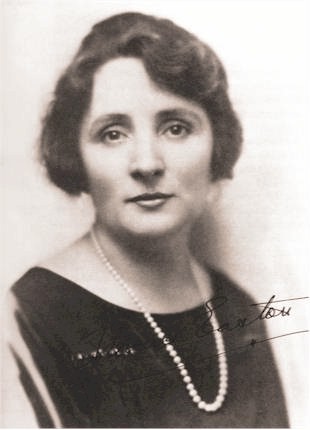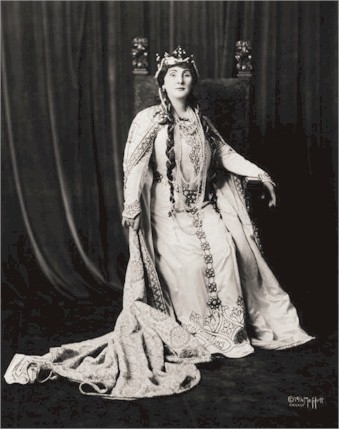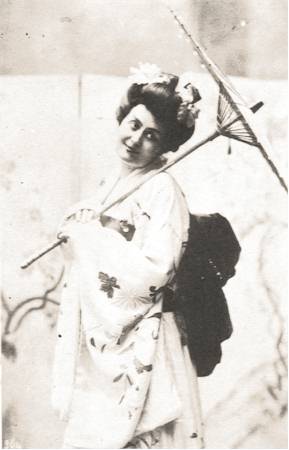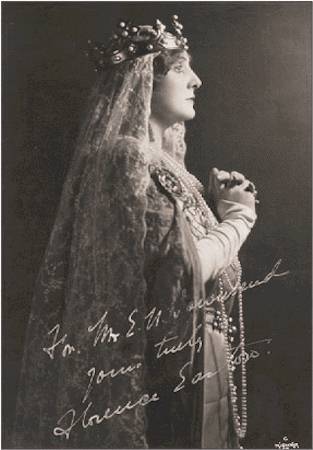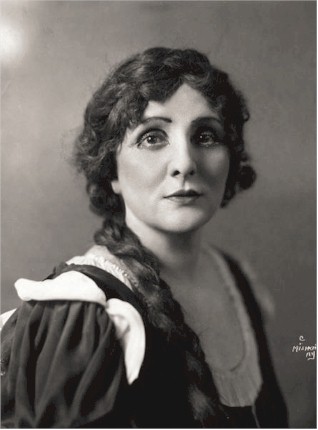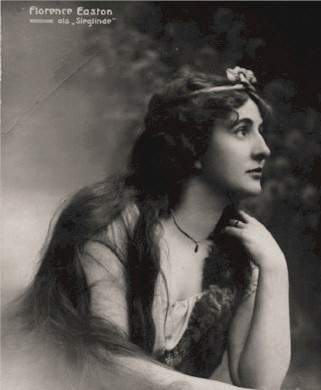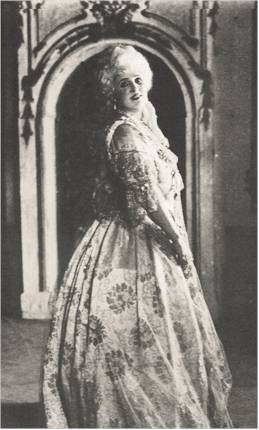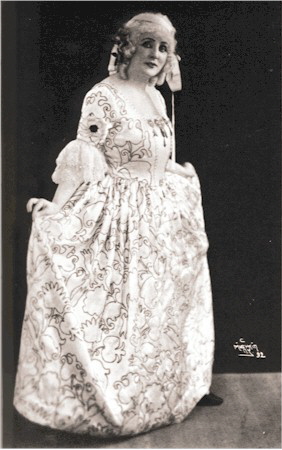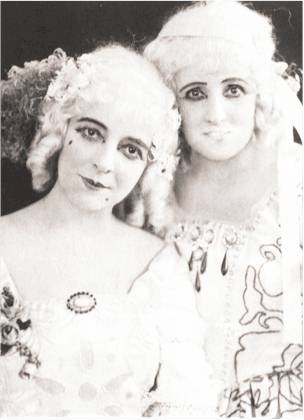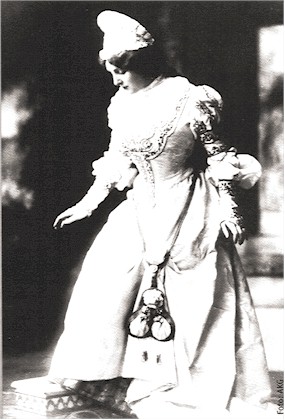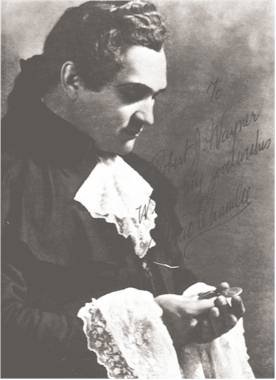English soprano, 1882 - 1955
Few sopranos have sung a wider repertory Biographical notes: (extract from the booklet of Claremont Records)
Florence Easton was born in South Bank (Yorkshire) on 25 October 1882. When she was five the family emigrated to Toronto, where she had piano, organ and singing lessons. Following the death
of her mother, she and her father returned to England in 1900 and she entered the Royal Academy of Music in London. After a year of training her voice she went to Paris to study with
Elliott Haslam. Her father died in 1902 and her grand-parents went so far as to choose a like-minded husband for her, but Florence got soon an engagement with the touring
Moody-Manners opera company, for whom she made her debut as the shepherd boy in Tannhäuser at Newcastle in 1903. On the first evening of the company’s season at Covent Garden she sang
Stephano in Roméo et Juliette. Her first leading role there was Arline in The Bohemian Girl. In May 1904 Easton married Francis MacLennon, an American Heldentenor with the Moody-Manners.
Two children were born in the following years. The couple moved to America in 1905, where MacLennon had the title role in Henry W. Savage’s Parsifal tour. Florence made her North
American debut as Gilda in Boston in November 1905. She also appeared as Gilda and Marguerite in Montreal and Toronto. Her first notable success came in Savage’s 1906/7 season as
Cio-Cio-San in the American premiere of Madame Butterfly (in English). After a stay in Germany, where her husband appeared as Turiddu, she made her debut at the Royal (later State) Opera
Berlin. She had to learn the role of Marguerite in German within 10 days. She did, and followed up by learning and performing the part of Aida within 48 hours without rehearsal. She was
immediately given a five-year contract. The ensuing period saw Florence Easton expand her repertoire and increase her reputation, with particular success as Cio-Cio-San and Sophie. The
couple was allowed to make guest appearances and she made a favorable impression at Covent Garden, again as Butterfly. She added a number of Wagnerian parts to her repertoire and
became an acclaimed Sieglinde, Gutrune, Elisabeth and Elsa.
As Elisabeth in “Tannhäuser” (by courtesy of Charles B. Mintzer)
As Cio-Cio-San
It was Richard Strauss who coached her as Elektra and Sophie (!) which she presented in English on a tour in Great Britain and in German in Berlin. After the 1912/13 season the MacLennans joined the Hamburg Opera with generous leave of absence allowed. She continued to expand her repertoire, the new role including Salome (again coached by Richard Strauss) and Minnie, singing the Part with Enrico Caruso in 1913. In 1915/16 the couple toured America where Florence appeared in a single performance as Brünnhilde in Siegfried, achieving a great popular and critical success. A few days later she sang Nedda (!). Because of the war it was to risky to return to Germany. So they stayd in the United Stats. Easton made her successful Met debut as Santuzza in 1917. She remained at the Met for 12 seasons, singing 41 parts and about 295 performances. It was her performance as the Saint Elisabeth in the staged version of Liszt’s Die Legende von der heiligen Elisabeth (1918) which set her into the first rank of Metropolitan stars.
As St Elisabeth in Liszt’s “Die Legende von der heiligen Elisabeth”
Among the further roles were Eva, Fiordiligi, Isolde, Leonora (Il Trovatore), the Marschallin (her
only Strauss role in the USA) and Rezia which she shared with Rosa Ponselle. Florence appeared for the first time with Caruso at the Met in Mascagni’s Lodoletta and in 1920 she was Rachel to
his Eleazar in La Juive, the great tenor’s final appearance. She sang in several world or American premieres, including the soprano parts in Gianni Schicchi and Taylor’s The King’s Henchman. It
was in the 1928/29 season when she left the Met company. During the Met years Easton also appeared frequently with the Ravinia Park Summer Opera in Chicago. Her roles there embraced a
number of roles which she did not sing elsewhere, including Zàzà (Leoncavallo), Manon Lescaut and Violetta. She also sang in concerts and recitals. In 1922 she appeared as Brünnhilde in
Siegfried opposite young Richard Crooks. In May 1929 she went to Europe for several months enjoying herself of the proceeds from years of singing with only a few short breaks.
As Gioconda (by courtesy of Charles B. Mintzer)
Back in New York, she quickly re-established herself, now as a recitalist whose interpretatons of Lieder were greatly admired. By now she was divorced from MacLennan and in 1931 she married Stanley Roberts; the happy couple decided to live in England. At Covent Garden in 1932 she was Isolde and the Siegfried Brünnhilde opposite Lauritz Melchior , the only time they appeared together. She was Tosca, Carmen (!), sang in Mendelssohn’s Elijah and gave Lieder and song recitals. Leaving England finally in 1935, she found that she had lost the tour to the new sensation, Kirsten Flagstad (but the artist remained an unstinting admirer of the great Norwegian). Easton’s last appearance on the operatic stage was in 1936 singing Brünnhilde in The Valkyrie at the Met. Her last appearance with orchestra was in a 1942 broadcast where she sang excerpts from Tristan and Isolde and using her own English translations! She then taught privately and at the Juilliard School of Music, and still gave occasional recitals in New York. Her final appearance was made at the Town Hall, in a song recital in 1943. At the end of the war the couple Roberts-Easton moved to Montreal. By now she was suffering from heart trouble and she died in 1955.
As Sieglinde in “Die Walküre” (by courtesy of Charles B. Mintzer)
“ In the fortnight between 3 and 17 November 1927 she sang Maddalena in Andrea Chénier, Gioconda, Rachel in La Juive, Butterfly and the Marschallin; it was surprising that she could manage them all and in such a relatively short space of time, it was astonishing that the critical response to nearly every one was laudatory. Though unlike her in so many ways Easton had this much in common with Lilli Lehmann. By dint of application, intelligence, musical facility and sheer hard work, she was able to transform a lightweight lyric soprano into a dramatic instrument capable not merely of scaling the Wagnerian heights but with the stamina to stay up there season in and season out.” Michael Scott (The Record of Singing, Vol. 2)
As the Marschallin (Princess Werdenberg)
As Fiordiligi in “Così fan tutte”, Met 1922
Frances Peralta (Dorabella) and Florence Easton (Fiordiligi), Met 1922 Comment:
Florence Easton was one of the most versatile singers of all time. She sang no fewer than 88 parts, covering a wide range of styles and periods, from Mozart, Meyerbeer, Gounod, Verdi,
Wagner, Puccini, Strauss, Schreker and Krenek. In Wagner she sang virtually every soprano part, large and small from Senta onwards, with the exception of the Götterdämmerung Brünnhilde.
Florence Easton described herself as “lyric dramatic soprano”, which seems barely adequate in relation to the range of types of role in which she excelled, rivalling Lilli Lehmann in this respect.
Her high international reputation, founded mainly in Germany and North America, was almost unique for a British singer of her time.
She could move easily through all stages from the light coloratura to the Hochdramatische, from girlish romanticism to powerful Wagnerian and Straussian drama. The voice could be light and
airy, gently melancholic or intensely passionate. The involvement in the character of the role was total. John Steane has suggested that “this great strength of hers was also, in a strange way, a
source of weakness. She sang so many roles very well that she never quite became identified with any of these”. Contemporary reviews and most of her superb records underline her great artistry.
As Eva in “Die Meistersinger von Nürnberg”
Florence Easton recorded for Odeon, Aeolian-Vocalion and for Brunswick (initially recording
acoustically, but electrically from 1926). The 46 items embraced opera, operetta, sacred songs and popular ballads. Then followed six operatic items for Edison (1927). One of the most
important Wagnerian records was made for HMV in 1932: “Heil dir Sonne! Heil dir Licht!” from Siegfried (the best recording in her own estimation). In 1933 HMV recorded six sides of Lieder
and songs for Victor, accompanied by Gerald Moore. The final studio recordings were made privately in 1940. Off-air recordings include two Götterdämmerung extracts from a Lewisohn
Stadium concert and 14 items (mainly Lieder) from a recital at the Juilliard School of Music (1939). Three Tristan excerpts (two with Arthur Carron plus the Liebestod) followed from the Celanese Hour broadcast (1942). Most of Wagnerian connoisseurs will have Easton’s superb Siegfried Brünnhilde opposite Lauritz Melchior (Covent Garden). I would like to present her in two less known recordings, made by
Brunswick in the 1920s when she was in her absolute prime. I do not want to leave unmentioned her wonderful partner Mario Chamlee.
Mario Chamlee (1892 - 1966)
Chamlee’s Met debut as Cavaradossi This fine American tenor (born Archer Cholmondeley) appeared at the Met in the seasons between 1921 - 1928 and 1936 - 1939
My warmest thanks to Charles B. Mintzer
|
|||||||||||||||||||||||||||||
